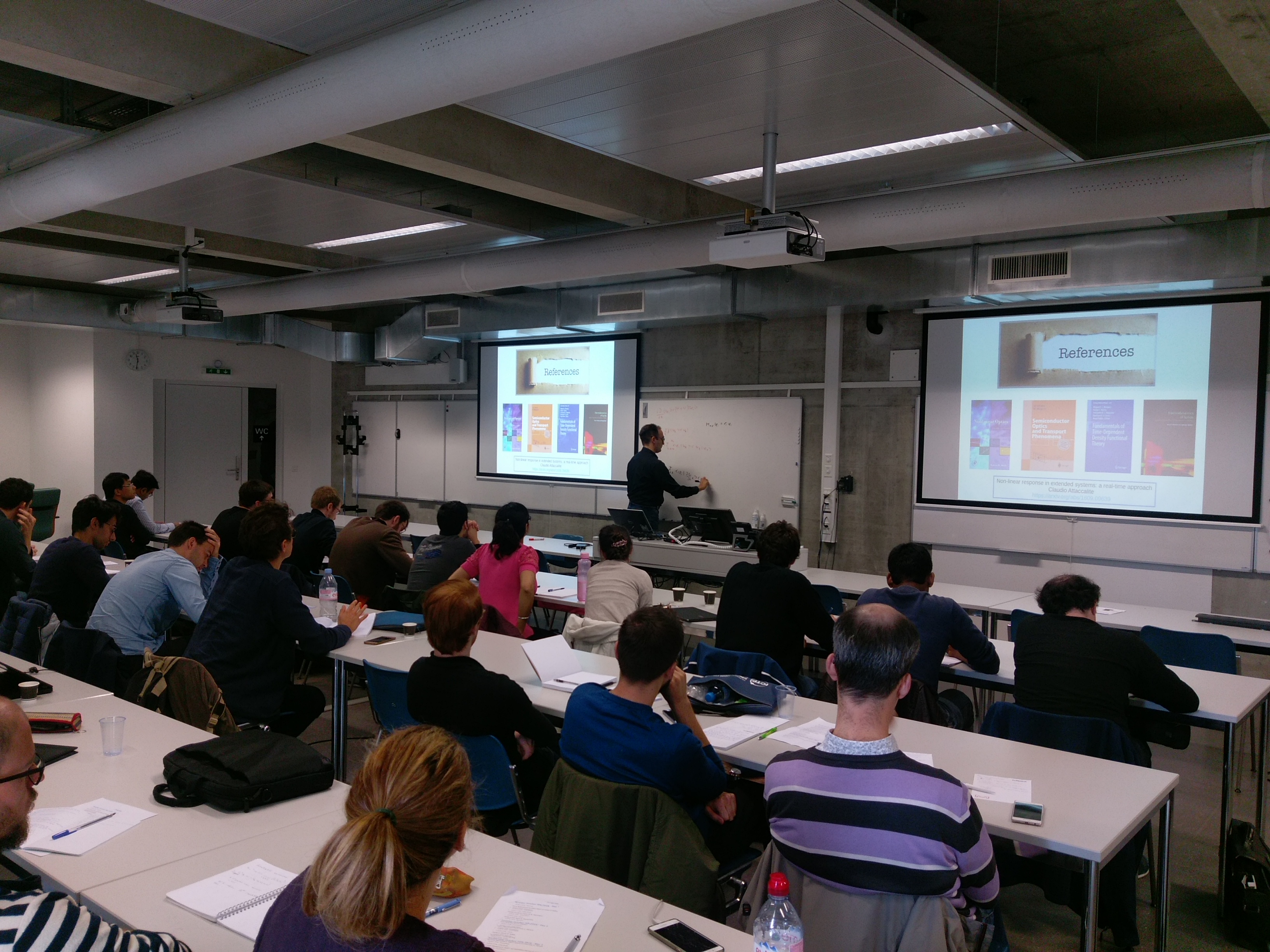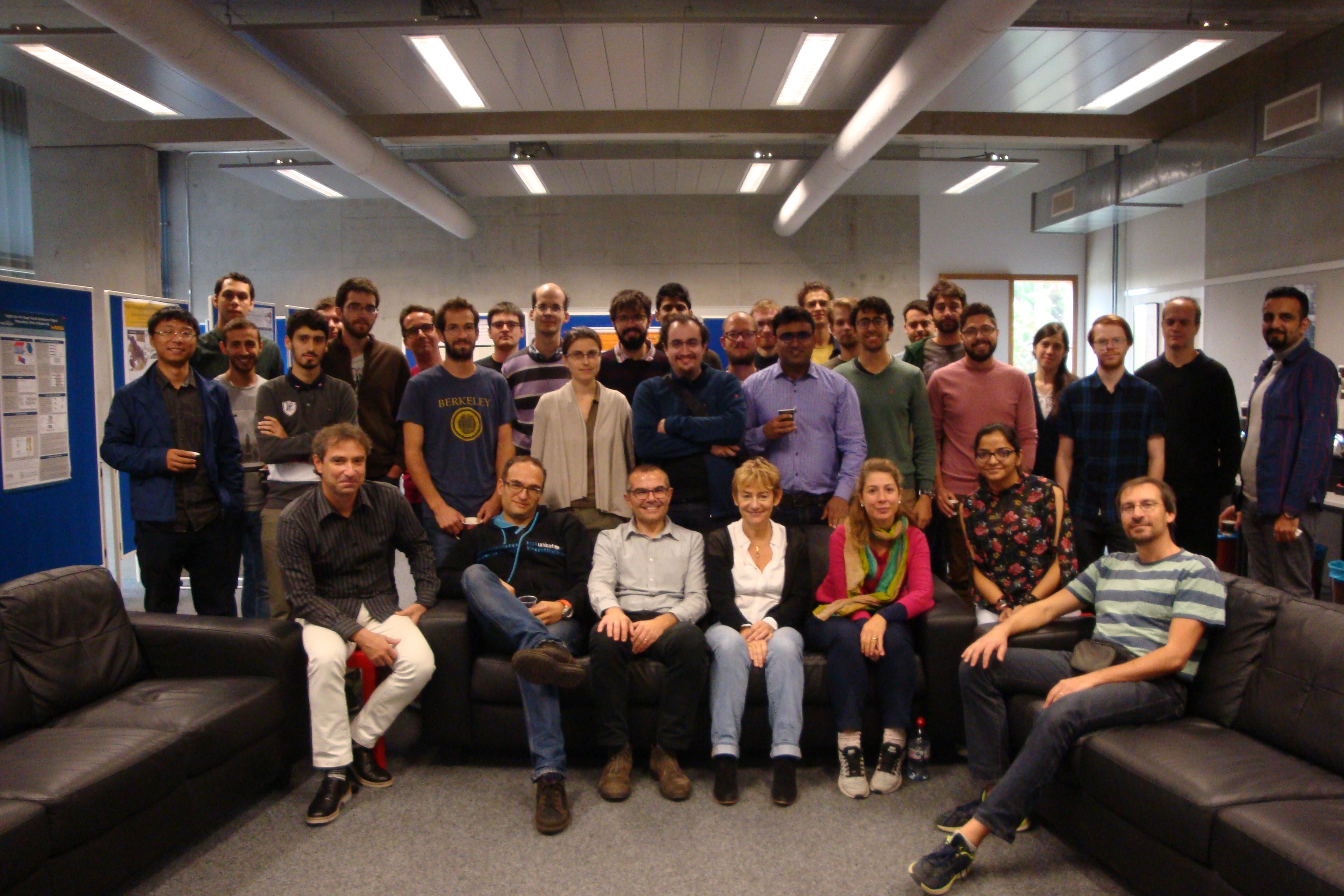October 8, 2018 to October 12, 2018
Location: CECAM-HQ-EPFL, Lausanne.
The aim of the school was to give a deep introduction on the theoretical and practical aspects of the electronic excitations, which are probed by experimental techniques such as optical absorption, EELS and photo-emission (direct or inverse). From the theory point of view, excitations and excited state properties are out of the reach of density-functional theory (DFT), which is a ground-state theory. In the last thirty years, other ab-initio theories and frameworks, which are able to describe electronic excitations and spectroscopy, have become more and more used: time-dependent density-functional theory (TDDFT) and many-body perturbation theory (MBPT) or Green’s function theory (GW approximation and Bethe-Salpeter equation BSE). In fact, computational solutions and codes have been developed in order to implement these theories and to provide tools to calculate excited state properties. The present school focused on these points, covering theoretical, practical, and also numerical aspects of TDDFT and MBPT, non-linear reponse and real-time spectroscopies. Finally, a large part of the school was devoted to the codes implementing such theories (ABINIT, 2Light, Lumen, DP, EXC).
Organisers:
- Francesco Sottile (Ecole Polytechnique, Palaiseau, France)
- Valerio Olevano (CNRS Institut Neel, Grenoble, France)
- Gian-Marco Rignanese (Université catholique de Louvain, Belgium)
Tutors:
- Claudio Attaccalite (Institut Neel, CNRS, Grenoble, France)
- Valerie Veniard (Ecole Polytechnique and CNRS, Palaiseau, France)
- Matteo Gatti (Ecole Polytechnique and CNRS, Palaiseau, France)
- Matteo Giantomassi (Université catholique de Louvain, Belgium)
- Francesco Sottile (Ecole Polytechnique, Palaiseau, France)
- Gian-Marco Rignanese (Université catholique de Louvain, Belgium)
- Valerio Olevano (Institut Neel, CNRS, Grenoble, France)
Format:
The format of the school was: i) presentation of the theory and theoretical aspects of the implementation took place in the morning sessions; ii) the afternoon sessions were devoted to practical hands-on of the theory studied in the morning: DFT with ABINIT (Day 1), TDDFT with DP (Day 2), Non-linear response within TDDFT with 2Light and Lumen (Day 3), GW approximation to MBPT with Abinit (Day 4) and Bethe-Salpeter with EXC and Lumen (Day 5).
Detailed description of the lectures:
- Introduction to spectroscopy. In this short introductory lecture (presented by F.Sottile), we described various experimental techniques used to investigate the spectroscopic properties of matter. We present the processes (scattering, absorption, and emission) resulting from the interaction of particles with matter, which are involved in those experimental techniques (photoemission spectroscopy (PES), inverse photoemission spectroscopy (IPES), x-ray absorption spectroscopy (XANES, EXAFS, and XANES), electron energy loss spectroscopy (EELS), inelastic x-ray scattering spectroscopy (IXS), reflectance anisotropy spectroscopy (RAS), Auger electron spectroscopy (AES), and X-Ray fluorescence spectroscopy (XRF)). For all methods, a link has been given to the quantities that can be computed using the theoretical methods in the subsequent lectures. An eminent role is covered by the inverse dielectric function ε-1(r,r’,ω), the screening function, which serves here as main motivation and guideline for the whole school.
- Micro-Macro connection. One hour lecture (by F.Sottile) on the connection between the measurable quantities (macroscopic) and calculated quantities (microscopic). This is a crucial concept, often disregarded. We find that this micro-macro connection is never well explained in textbooks or articles, rather given for granted, in partcular for what concerns optical absorption.
- Density-Functional Theory. This lecture (presented by G.-M.Rignanese) covered the basics of density-functional theory: formalism and implementation. A special care was taken to present the shortcomings of Density Functional Theory as concerns its use for the computation of band structure, and , on the other hand, its usefulness as a starting point for more elaborate theories. The topics covered: the electronic N-body problem, functionals of the density, the Kohn-Sham approach, approximations and new functionals, the band gap problem. In addition, more technical concepts (related to the plane-wave approach to be followed in the hands-on) were explained: plane wave basis set, Brillouin zone integration, pseudopotentials, relaxation via computing the forces, iterative algorithms. And of course, the ABINIT code was presented.
- Time Dependent Density Functional Theory. A review (presented by V.Olevano) of time-dependent density-functional theory and its foundamental assumptions, theorems, caveats and drawbacks has been presented. In particular, we have illustrated the Linear-Response TDDFT in an actual implementation which is in Frequency domain, reciprocal space and on a Plane-Waves basis, as implemented in the DP (Dielectric Properties, http://www.dp-code.org) code. This scheme is well suited to EELS and optical spectroscopy calculations, and particularly convenient for infinite periodic bulk solids, but also semi-infinite systems like surfaces, wires and tubes by the use of supercells. A critical analysis of all the classical approximations (RPA, Adiabatic LDA, with and without local-field effects) as well as the most recent ones (long-range contribution only, Nanonoquanta kernel, Bootstrap, etc.) has been presented together with illustrating examples of spectra on prototype condensed matter systems, like bulk silicon, graphite, nanotubes, etc. This lecture was followed by a practical session on the use of DP code.

- Non linear response: perturbative approach. Non-linear approaches constitute the novelty of this edition of the Spectrscopy Lectures. In the first lecture (by V.Véniard) the perturbative approach is presented, with the description of second and third order responses. In particular, it was emphasized the intrinsic difficulties of the inclusion of local fields and the exchange and correlation contribution beyond RPA (with terms like the third -or fourth- derivative of the xc energy with respect to the density). Exercises with 2light in the afternoon.
- Non linear response: time evolution approach. Together with the perturbative approach, also the real time evolution approach was presented (by C.Attaccalite), in which all orders are automatically included. This permits both to tackle non perturbative regime (like high harmonic generation) and to introduce importance concepts (Dephasing, Berry phase, etc.). Exercises with Lumen in the afternoon.
- Many-Body Perturbation Theory and GW approximation. In these lectures (presented by M.Gatti and M.Giantomassi), we introduced the theoretical basics of many-body Green’s functions theory. Starting from the very basic concept of the Green’s function based on second quantization operators, and motivated by spectroscopic reasons (what is an electron? How do we measure the energy of an electron?), the theory developed to the Hedin’s equations and, finally, to the most typical approximations of the self-energy: Hartree-Fock, CohSex, and GW approximation. The latter has been shown to be very successful in predicting the band gaps of solids. It improves significantly over the standard density-functional approaches for the electronic structure. The central quantities are the Green’s function G and the screened Coulomb interaction W. In this framework, the GW approximation appears naturally as a first order approximation in the “small” quantity W. But, together with the formal derivation of the GW approximation, and in order to elucidate the physical content of the GW approximation, we show that the GW approximation is a natural improvement over the well known Hartree-Fock scheme. An important part of the lectures is devoted to the practical aspects: creation of the ground-state with a correct pseudo-potential and the RPA screening file, convergence with respect to many parameters (bands, k-points, plane waves, G-vectors, self consistent iterations, etc.), concept of self-consistency (QPSCGW, self-consistent cohsex, only-energy self-consistency, etc.).
- Bethe-Salpeter Equation. This lecture (by F.Sottile) presents the Many-Body approach for the description of polarizability. Within the Green’s functions formalism, the linear response polarizability is given by the 2-particle Green’s function which obeys a Dyson-like equation, similarly to the linear response TDDFT equation. The derivation of the Bethe-Salpeter Equation as well all the approximations involved in the (several) steps are illustrated in this lecture, before presenting the numerical aspects useful for the afternoon hands-on with the EXC code.
- Real time spectroscopy. The possibility to use the time evolution technique is shown in all its power to tackle the Bethe-Salpeter equation, and go beyond linear response (by C.Attaccalite). Again, several point of views have been given: the theoretical explanation and derivation, as well as the technical details to carry out the hands-on with Lumen.

Hands-on:
The practical exercises took place in the afternoon. We installed the codes (and all related and useful softwares – libraries, visualization tools) on the EPFL cluster, of which we had allocated 10 32-cores nodes for our school (monday to friday). The procedure to reach the cluster is a bit heavy (it’s not Cecam’s, but of the EPFL), but after some misunderstanding on monday afternoon, everything procedeed smoothly.
The exercises were very varied, ranging from the simple codes’ tutorials (available on the web) to more realistic calculations (converged results for a system of choice by the student), so reflecting the heterogenenous audience: some young students were actually trying a DFT code for the first time, some others were already proficient with DFT and wanted to do “real stuff” with TDDFT and BSE, for instance. The possibility to run on a cluster (with potentially many processors at our disposal) permitted this.
Program
- Day 1 – Monday 8 Oct
Welcome: objectives of the school (F.Sottile)
Introduction on Spectroscopy (F.Sottile)
Micro-Macro Connection (F.Sottile)
Coffee Break
Density Functional Theory (G.-M. Rignanese)
Lunch break
Hands-on with Abinit (M. Giantomassi) - Day 2 – Tuesday 9 Oct
Time Dependent DFT (V. Olevano)
Coffee Break
Linear response and the DP code (V. Olevano)
Lunch
Hands-on with DP (F. Sottile)
Social Dinner - Day 3 – Wednesday 10 Oct
Non-linear approaches to TDDFT :: second and third order (V. Veniard)
Coffee Break
Non-linear approaches to TDDFT :: non perturbative real-time (C. Attaccalite)
Lunch
Hands-on with 2Light and Lumen (V. Veniard and C. Attaccalite) - Day 4 – Thursday 11 Oct
Many-Body Perturbation Theory (M. Gatti)
Coffee Break
GWA :: theory and practicalities (M. Giantomassi)
Lunch
Hands-on with Abinit (M. Giantomassi) - Day 5 Friday 12 Oct
Bethe-Salpeter Equation (F. Sottile)
Coffee Break
BSE in real time (C. Attaccalite)
Lunch
Hands-on with EXC and Lumen (F. Sottile)
Extra:
General Remarks:
From the organizers’ point of view the school has been a frank success. Thanks also to the cumulated experience of last editions, and to a good team-work among tutors, the lectures have been largely considered appropriate in length, complexity and clarity, by the students. The participation level has always been very high, and we have been glad to notice how the discussion time has always been stretched much over the allocated time, in particular for the most sensible lectures (MBPT and TDDFT).
Another element that helped creating a nice atmosphere and engaging the students was the use of real-time games (using web platform like Kahoot and Quizizz): this competition/game support permitted both to check the general level of the students’ knowledge on certain topics, and to create an engaging situation among students (everybody wants to win a game, when playing). The final results and ranking created discussion, questions by sometime astonished students, and curious/creative comments. It was overall entertaining and useful. The school was originally designed to host 20-22 participants, but given the number of request (made by highly qualified students) we have increased the number of participants to 30. In order to increase the discussion and connection among students (and also between students and tutors) we asked the students to bring a poster of their research (not obligatory).
All participants attended the social dinner on Tuesday. We managed to organize another event all together on thursday night.
Finally, we want to point out that the organization and the connection with Charlotte Sterling, Bogdan Nichita and Nathalie Carminati (at Cecam HQ) was flawless (many thanks for all this), and we have no problems to report.
We are looking forward to organising another event in a couple of years.

